Virtual reality (VR) is a cutting-edge technology that has revolutionized the way we experience and interact with digital content. With its ability to create immersive and interactive learning environments, VR is becoming an increasingly popular tool for student engagement in classrooms around the world.
One of the main advantages of virtual reality for student engagement is that it allows students to experience learning in a more interactive and hands-on way. Rather than simply reading or listening to information, they can explore new environments and interact with virtual objects and characters in real-time. This can help students better understand complex concepts and retain information more effectively.
For example, virtual reality can be used to simulate laboratory experiments that would otherwise be too dangerous or expensive to conduct in real life. Students can safely explore the inside of a human body to learn about anatomy, or study the behavior of different species without risking their safety. These types of experiences can help students develop critical thinking skills and gain a deeper understanding of the subject matter.
Another benefit of virtual reality for student engagement is that it can make learning more fun and engaging. When students are enjoying what they’re learning, they are more likely to be motivated and engaged in the learning process. Virtual reality can be used to create immersive games or simulations that teach important concepts while keeping students entertained.
One real-world example of virtual reality being used for student engagement is the use of virtual field trips. With virtual reality, students can explore different parts of the world or visit historical sites without ever leaving the classroom. This can help students gain a broader perspective on different cultures and time periods, as well as provide them with new experiences that they might not otherwise have had access to.
In addition to its interactive and engaging benefits, virtual reality can also be used for student collaboration and communication. With virtual reality, students can work together in virtual environments to solve problems and complete tasks, which can help them develop teamwork and communication skills.
Another example of how virtual reality is being used for student engagement is in the field of art and design. Virtual reality can be used to create immersive digital art installations that allow students to explore new forms of expression and experiment with different styles and techniques. This can help students develop their creativity and artistic skills while also gaining a deeper understanding of the creative process.
Virtual reality is also being used in language learning. With virtual reality, students can practice speaking and listening skills in realistic situations, such as ordering food at a restaurant or asking for directions. This can help students develop fluency and cultural competence in different languages.
Overall, virtual reality is an exciting tool for student engagement that has the potential to revolutionize the way we teach and learn. By providing immersive and interactive learning environments, virtual reality can help students better understand complex concepts, retain information more effectively, and develop important skills like critical thinking, teamwork, and creativity. As virtual reality technology continues to evolve, we can expect to see even more innovative uses of this powerful tool in classrooms around the world.

